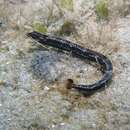fr
noms dans le fil d’Ariane


Cosmocampus brachycephalus és una espècie de peix de la família dels singnàtids i de l'ordre dels singnatiformes.
És ovovivípar i el mascle transporta els ous en una bossa ventral, la qual es troba a sota de la cua.[5]
A Cuba és depredat per Carangoides ruber.[6][7]
És un peix marí de clima tropical.[3]
Es troba des del sud de Florida (Estats Units) i les Bahames[8] fins al nord de Sud-amèrica.[3][9][10][11][12][13][14][15]
Cosmocampus brachycephalus és una espècie de peix de la família dels singnàtids i de l'ordre dels singnatiformes.
Cosmocampus brachycephalus (American crested pipefish) is a species of marine fish of the family Syngnathidae. It is found in the western Atlantic Ocean, near southern Florida (USA), the Bahamas, and northern South America.[1] It lives in sub-tidal grass flats to depths of 10 metres (33 ft), where it can grow to lengths of 10 centimetres (3.9 in). This species ovoviviparous, with males carrying eggs and giving birth to live young.[2]
This species can be distinguished by its prominent crest on top of its head, as well as its black stripes.[3]
Cosmocampus brachycephalus (American crested pipefish) is a species of marine fish of the family Syngnathidae. It is found in the western Atlantic Ocean, near southern Florida (USA), the Bahamas, and northern South America. It lives in sub-tidal grass flats to depths of 10 metres (33 ft), where it can grow to lengths of 10 centimetres (3.9 in). This species ovoviviparous, with males carrying eggs and giving birth to live young.
Cosmocampus brachycephalus es una especie de pez de la familia Syngnathidae en el orden de los Syngnathiformes.
•Los machos pueden alcanzar 10 cm de longitud total.[1][2]
Es ovovivíparo y el macho transporta los huevos en una bolsa ventral, la cual se encuentra debajo de la cola.[3]
En Cuba es depredado por Carangoides ruber .
Es un pez de mar y de clima tropical.
Se encuentra desde el sur de Florida (Estados Unidos) y las Bahamas hasta el norte de Sudamérica.
Cosmocampus brachycephalus es una especie de pez de la familia Syngnathidae en el orden de los Syngnathiformes.
Cosmocampus brachycephalus Cosmocampus generoko animalia da. Arrainen barruko Syngnathidae familian sailkatzen da.
Cosmocampus brachycephalus Cosmocampus generoko animalia da. Arrainen barruko Syngnathidae familian sailkatzen da.
Cosmocampus brachycephalus is een straalvinnige vissensoort uit de familie van zeenaalden en zeepaardjes (Syngnathidae).[2] De wetenschappelijke naam van de soort is voor het eerst geldig gepubliceerd in 1868 door Poey.
Bronnen, noten en/of referenties短頭環宇海龍(学名:Cosmocampus brachycephalus),为輻鰭魚綱棘背魚目海龍科的其中一種,分布於西大西洋區,包括美國佛羅里達州、墨西哥、加勒比海、委內瑞拉等海域,體長可達10公分,棲息在珊瑚礁區,卵胎生。
短頭環宇海龍(学名:Cosmocampus brachycephalus),为輻鰭魚綱棘背魚目海龍科的其中一種,分布於西大西洋區,包括美國佛羅里達州、墨西哥、加勒比海、委內瑞拉等海域,體長可達10公分,棲息在珊瑚礁區,卵胎生。